THE HISTORY OF MECCA | home
THE HISTORY OF MECCA | GEOGRAPHY OF MECCA - ISLAM | ARCHAEOLOGY OF MECCA | BACA IS MECCA? | HISTORICAL CLAIMS REGARDING MECCA | ORIGINS OF ISLAM | RESOURCES | CONTACT
HISTORICAL CLAIMS REGARDING MECCA
To consider the Gospel with an Islamic perspective please visit IslamAndTheTruth.com
Besides Ahmed Deedat's Baca is Mecca exercise in dissimulation, by censoring the location pin provided in Psalms 84 as revealed on the prior page, it is amazing how many Muslims parrot other Muslims that advance a handful of out of context quotes that were gleaned from a few 18th or 19th century author's misunderstanding of an earlier historian or geographer, as if doing so could somehow take the place of an entirely absent 4500 year pre-4th century historical and archaeological record of Mecca! Compare that absence of evidence, to the historical and archaeological records of the Holy Land, where there are over a million artifacts just on display! Let alone the miracle of fulfilled Bible prophecy.
(URL) Historical fact intermingled with "tradition"
Muhammad's followers present links to publications like Encyclopedia Britannica, with suggestions that it proves that Abraham and Ishmael built the Kaaba, or that Mecca existed prior to the 4th century AD. Part of the reason for their being deceived is that many publications misleadingly intermingle Islamic so-called "tradition", with matters of Muhammad-era and later historical record, rather than creating a separate category for the unhistorical Islamic fiction labeled "tradition" that was created and put to the pen in the 7th to 10th centuries without reference to any actual historical record that preceded the 6th century AD.
Wikipedia has the excuse of being vulnerable to any vandal that creates a login, but would it be asking too much to expect more care to be exercised by publications that promote themselves as being authoritative sources of factual information, that even proclaim hollow unctuous platitudes such as "truth matters"? Yet because they lump fact and fictional "tradition" together, under the category of "History", it creates a false illusion of Islamic "tradition" regarding ancient history as being historical. This exceedingly unscholarly approach is misleading, even though most publications carefully couch any references that suggest a pre-4th century AD Mecca or Kaaba, with qualifiers like "According to Islamic tradition...." or "According to legend....". Yet because historical fact and Islamic "tradition" are intertwined under the heading of "history" in these publications, young students and others with limited capacity for critical thought or those that are simply predisposed to believe unhistorical Islamic fables, fail to notice that those "qualifiers" are in effect disclaimers that if anything suggest an absence of historicity. In the end such articles wind up as little more than exercises in mind control, whether intended or not.
(URL) Antiquated Sources
It is important to note that available evidence suggests the Arabic language did not exist until into the Christian era, yet some go as far as to suggest similarities between names of places like that of 2nd century Ptolemy's "Macoraba" with "Mecca" (perhaps because they both begin with an "m"?).
Yet in spite of the fact that nobody can deny that such vain wishes are not evidential, we find an endless procession of those that try to rename Mecca, as if it were synonymous or interchangeable with "Macoraba" and even "Baca". Once again, the antiquated 18th to early 20th century dictionaries and encyclopedias are parroted without end, even by modern day encyclopedias!
When it comes to events that took place during the 18th to early 20th centuries, or even a century or two before the period the author was contemporary to, the information they pass along may well be reliable and historical. Indeed that is how historical record is developed. But when it comes to an 18th to early 20th century author passing along fables from unhistorical sources, regarding things that were supposed to have taken place thousands of years before them, they were obviously as information deprived as some modern day parrots choose to be, who regurgitate the same.
The most commonly cited author on this subject, perhaps because Ahmed Deedat parroted the notion, is 18th century author Edward Gibbon's citing of 2nd century Diodorus' writing about Agatharchides work. Muslims quote from Gibbon's "Decline and Fall of the Roman Empire" regarding "...a famous temple, whose superior sanctity was revered by all the Arabians...", in which Gibbon parroted Diodorus' ".....is highly revered by all the Arabs", that by the 1700s Gibbon understandably presumed through Islamic folklore was the Ka'aba in Mecca. However Gibbon's area of interest was the Roman Empire, and he offers his readers ample warning regarding his relative disinterest in the subject of Arabia, by prefacing the passage that quote is lifted from with: "I am ignorant, and I am careless, of the blind mythology of the Barbarians: of the local deities, of the stars, the air, and the earth, of their sex or titles, their attributes or subordination." After which he goes on to parrot unhistorical Islamic "tradition" regarding the kaaba and Mecca. It should be no surprise that by the time the 1700s rolled around, an Englishman that had expressed a less than enthusiastic interest in Arabia would falsely presume that the "famous temple" written about by Diodorus was the Ka'aba, while the evidence suggests otherwise. By Gibbon's 18th century the Kaaba had been the only show in Arabia for more than 1,000 years, because Muhammad and his followers had destroyed all of the other places of worship during their ravaging rampage of the Arabian Peninsula.
However even Mohammed's own tribe the Quraish continued to go on pilgrimage to other temples twice a year, long after they built their Ka'aba in Mecca in the 5th century, indicating that the Ka'aba in Mecca was a less significant site of pagan Arabian Star Family worship.
Quran 106:1 For the covenants by the Quraish, 2 Their covenants journeys by winter and summer,- 3 Let them adore the Lord of this House,
One of the Quraish pilgrimages was to a Ka'aba in Taif where the sun goddess al-Lat was worshiped, who was the wife of what the etymology of the name would suggest was the Arabian pagan's moon god al-Lah. Which also helps us recognize the origins of the Islamic ritual of Ramadan.
Another pilgrimage was to the north. Quoting Dr. Rafat Amari "Agatharchides told about another temple close to Ilat in the Aqaba gulf area. It is in a land belonging to a tribe called "Batmizomaneis." Agatharchides emphasizes that the temple, in his own words, "is highly revered by all the Arabs." (1)
Thus we can understand why the Arabian expression "Allah Akbar" of pagans that worshiped 360 idols in Mecca before Muhammad was born, is an exclamation that Allah is the greater or greatest, of all the Arabian Star Family deities.
Yet another possibility for a famous Arabian temple, could be the one near al-Ula (formerly Dedan) where she-camels were taken to be sacrificed to the God Dhu Ghaibat, that is explored further down the page.
(URL) Macoraba was Mecca
A purely speculative, and as becomes increasingly obvious false, presumption, that is clung to in great desperation - as if it could take the place of 4500 year's worth of absent historical and archaeological evidence of a pre-4th century Mecca - is suggestion that Ptolemy's "Macoraba" was Mecca, even through claims of similarity between the two words (perhaps because they both begin with an "m"?), even though the Arabic language did not exist until into the Christian era.
For a 21st century information age presentation of Ptolemy's work, as opposed to parroted Islamic so-called "tradition" and dissimulation from obsolete sources, we urge you to visit this link to a paper titled Suggested Solutions for Issues Concerning The Location of Mecca in Ptolemy’s Geography by Dan Gibson (2013) at academia.edu, for a well reasoned, computer enhanced, locating of Ptolemy's coordinates as adjusted to a modern map (if short on time please scroll to the summary on pages 11 to 14 at that link). To quote a few snippets:
"Over time the names of cities and villages change and ruins crumble and disappear, but river courses, while they may change slightly, are long lasting. Even though water may not flow year round, or perhaps even at all, the existence of the ancient river courses help provide us with several solid coordinates that we can use to bridge between Ptolemy and the globe as we know it today."
"There are a number of city locations on Ptolemy’s map which are well known today. He correctly identifies the Yemeni ports of Muza, Aden (Emporiu Arabia), and Cane. This provides us with four rivers and three coastal cities that we can identify today."
"We then decided to place Ptolemy’s coordinates on a grid without any reference to any maps. Then we would try and match the rivers to see what Ptolemy had done."
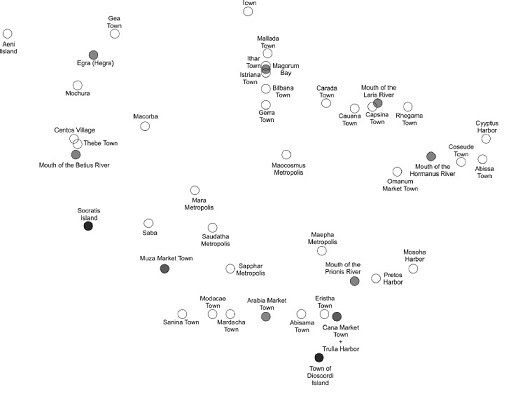
"When we attempted to overlay these coordinates on a modern map many problems arose when trying to fit them correctly. (See below)"
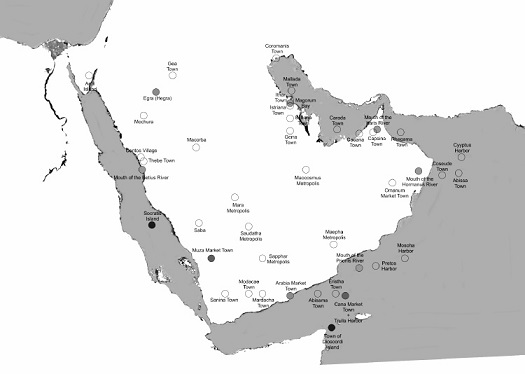
"The solution to this was to manipulate Ptolemy’s coordinates until the rivers lined up. In order to do this we left two places on Ptolemy’s map in the north. Egra (Hegra), known as Mada’in Saleh today, and Gea Town which aligned with ancient Tayma. We then grouped the Beitius River and the other locations near to it and move them all southward until the Betius River was over Wadi Mawr. (The other grouped locations also moved southward). When we did this, many of the interior locations suddenly became apparent. In short, we matched Ptolemy’s Rivers to the location of the rivers today to obtain a correct map of Arabia. In doing so it became apparent that Ptolemy was not aware of the vastness of the deserts in Arabia’s interior, and that he plotted the locations in Yemen too far north.
Once we had shrunk Ptolemy’s map southward (with a small twist on the bottom to correct Ptolemy’s angle) many of the locations on Ptolemy’s map suddenly fit. Ptolomey’s Centros Village became modern day Jazan, Tebe Town became AlLuhayyah and Macoraba became Al-Mahabishah. Mara was then positioned as Ma’rib and Saudatha became modern day Sana’a. Sapphar then fit over Zafar, and Mochura in the north became Yenbu. On the Indian Ocean coast Petros became modern day Salalah and Mosoha is what we know today as ancient Sumhuram."
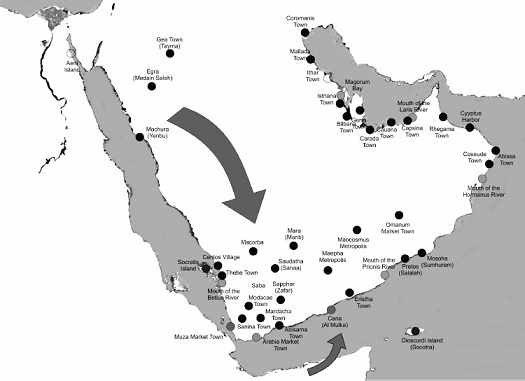
If these excerpts interested you, please click on this link for additional information on the historical context, methodology and formulas used, aerial photos of the riverbeds and much more.
From Mr. Gibson's study we confirm that Macoraba was not only an interior settlement of Arabia by any measure (as posited by so many others), but as per Dr. Rafat Amari it was a relatively new settlement at the time that Ptolemy wrote about it, so even if Macoraba had been where Mecca was initially established (in the 4th century AD by the earliest estimates), it would only further confirm that Mecca was relatively new to the scene. From Dr. Rafat Amari:
"Studies by Classical Writers Show That Mecca Could Not Have Been Built Before the 4th Century A.D.
From a practical standpoint, Ptolemy’s criteria proves valuable when looking for other cities in the Middle East mentioned by him, or even by those in his own country, Egypt. Based on these facts, his work helps us resolve the location problem for some cities, such as Macoraba, which appeared in his generation.
In book six, chapter seven, of his work titled Geography, Ptolemy documents the latitude and longitude coordinates of several landmarks in Arabia.[lxxxix] By studying these locations and coordinates, we notice once again that the city of Mecca is never mentioned. In fact, Ptolemy doesn't mention any cities in the strip of land where Mecca was eventually built.
Macoraba was a city in the Arabian interior which was mentioned by Ptolemy. Some people wanted to assume that Macoraba was actually Mecca. Macoraba had appeared recently, with respect to Ptolemy’s time. This assumption would result in the conclusion that Mecca was built around the middle of the 2nd century A.D. However, even if this were true, it wouldn't support the claim that Mecca was an old city existing from the time of Abraham. Upon further study of the facts concerning Macoraba, we can conclude with certainty that Macoraba cannot be Mecca, and we can refute the idea that Mecca was built in the 2nd century A.D. All the facts point to the historical argument that Mecca was constructed in the 4th century A.D. Since Macoraba is not pronounced like Mecca, the scholar Crone suggested that the location of Maqarib, near Yathrib, was actually Macoraba. Maqarib is mentioned by Yaqut al-Hamawi, an Arab geographer who lived from 1179-1229 A.D., in his geographical dictionary Mujam al-Buldan.[xc] This location is more acceptable than Mecca for the modern-day location of Macoraba, because Maqarib is closer in pronunciation to Macoraba than to Mecca. Another reason is that Maqarib, though it does not exactly fit the documented location of Macoraba, is closer to the location, according to the latitude and longitude of Ptolemy, than Mecca is to the documented location of Macoraba."
One thing that is absolutely not arguable, is that obsolete and discredited wishful false presumption, will never be able to stand in for a completely absent 4500 year pre-4th century historical and archaeological record of Mecca. As even Saudi Arabia's museums confirm by an absence of the same.
Like in the Islamic Museum in Mecca. Or the National Museum of Saudi Arabia's page on the pre-Islamic era, where we find discussion of older habitation in northern Arabia, the Yemen area, and even Riyadh - but still no Mecca.
(URL) More scripture Muslims cite, that backfires against Islam
Some Muslims actually try to further the case for Mecca, by quoting other passages of scripture. But there is good reason the scriptures always backfire against the abuse of Muhammad's followers, who are compelled by Muhammad to disbelieve the scriptures:
Heb 4:12 For the word of God is quick, and powerful, and sharper than any twoedged sword, piercing even to the dividing asunder of soul and spirit, and of the joints and marrow, and is a discerner of the thoughts and intents of the heart.
One of the verses that has been presented to me, by a Muslim that even publishes his own website, is:
"14 So Abraham rose early in the morning, and took bread and a skin of water; and putting it on her shoulder, he gave it and the boy to Hagar, and sent her away. Then she departed and wandered in the Wilderness of Beersheba...... 21 He dwelt in the Wilderness of Paran; and his mother took a wife for him from the land of Egypt."
Emphasis is his. Are we actually supposed to believe that Hagar wandered 1,200 kilometers from Hebron to Mecca, a thousand years before a caravan route was established along the Red Sea? Or that Hagar wandered across 1,200 kilometers of harsh barren unexplored untraveled desert from Mecca to Egypt and back to Mecca with Ishmael's wife?
This poor fellow sarcastically asked: "How did they get to these 2 places? By winged donkeys? That is a problem that YOU have to solve!", which of course the map easily resolves. His sarcasm arose because earlier in the chat I had mentioned that when Ibn Ishak recognized the geographical impossibility of Islamic "tradition" regarding Abraham, Hagar and Ishmael, he simply made the claim that Abraham regularly rode back and forth on flying donkey-mules (Tarikh al-Tabari, I, page 165) like the one that Muhammad claimed he rode on one night.
All this poor person would have needed to do is web search confirmation of the location of Beersheba and Paran, as detailed on the following map that I had presented to him earlier, which includes both the traditional presumed locations, and new suggested locations of the Wilderness of Beersheba and Paran. With Beersheba where Hagar found the well being just south of Abraham's home in Hebron, and Hebron being just south of Jerusalem, which of course makes perfect geographical sense. Yet Muslims are expected to believe that Hagar wandered across 1400 kilometers of dry barren desert before getting a drink at the well of Zamzam in Mecca?! Let alone that there was no overland travel from north to south in Arabia by anybody, until over a thousand years after Hagar lived.
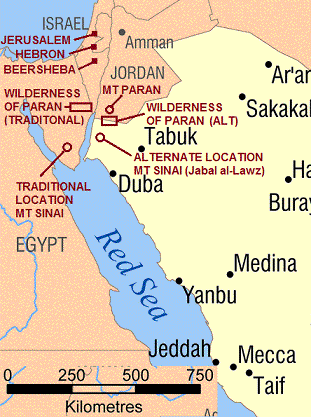
Muhammad's follower also noted: "The Bible clearly says that Paran is south of Sinai in Egypt; "He said: 'The LORD came from Sinai and dawned over them from Seir; he shone forth from Mount Paran. He came with myriads of holy ones from the south, from his mountain slopes.' (From the NIV Bible, Deuteronomy 33:2)"
Simply looking at the map shows us that all locations of this discussion were at the southern edge of Israel, and as the passage indicates it is about the tribes of Israel. It is sad, but not uncommon, for Muslims to be misled by their Greek sophist styled entertainers like Ahmed Deedat who himself attempted this ridiculous argument, who unfortunately employ heavily compromised pop-modern Bible versions. No other version includes "from the south". Nor does the Hebrew English interlinear. Here's the KJV with a little more context:
Deu 33:1 And this is the blessing, wherewith Moses the man of God blessed the children of Israel before his death. 2 And he said, The LORD came from Sinai, and rose up from Seir unto them; he shined forth from mount Paran, and he came with ten thousands of saints: from his right hand went a fiery law for them. 3 Yea, he loved the people; all his saints are in thy hand: and they sat down at thy feet; every one shall receive of thy words. 4 Moses commanded us a law, even the inheritance of the congregation of Jacob.
So the compromised version's addition is a moot point since God's "holy ones" were the tribes of Israel as indicated by the chapter, along with accompanying reference to that "fiery law" being the law Moses commanded (from YHWH) as made abundantly clear by the next two verses, and those after that continue to even name specific tribes of Israel. Obviously not a reference to some Arabian pagan's law that requires Muhammad's followers to prostrate themselves toward the Quraish pagan's black stone idol in Mecca five times a day.
"Mt. Paran" from the verse is in today's Jordan.
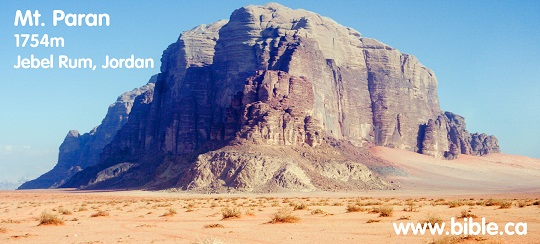
Regarding "Seir" or Shur we can see the location on this map:

Finally the Muslim quoted: "Now Hagar stands for Mount Sinai in Arabia and corresponds to the present city of Jerusalem, because she is in slavery with her children. (From the NIV Bible, Galatians 4:25)"
It really requires desperation for a Muslim to quote this verse, since this passage is all about the seed of Ishmael specifically not being considered children of Abraham, that are "in slavery" or bondage to the flesh, rather than being of the spirit as are the children of the promise in Isaac.
This verse however, along with presumptions based on some field work, are largely responsible for generating the interest in the alternate locations as detailed on both maps. However, while the Sinai Peninsula is not a part of Arabia today, the bulk of the evidence suggests that it was indeed a part of ancient Arabia. But obviously nothing will ever move God's people and The Holy Land any closer than 1,000 kilometers away from where Mecca was eventually settled in the 4th century
AD. Preposterouls suggestion of Mecca having anything to do, with YHWH and His people of the scriptures, is a demographic and geographical impossibility. The irrevocable fact of the matter remains, that there was no overland travel along the Red Sea until about the 6th century BC, over a thousand years after Abraham.
Since he was responsible for so many of the lies that are parroted, is it really that much of a stretch to suggest that this style of modern day Muslims, effectively worship Ahmed Deedat?
Qibla (Qiblah) of the Oldest Mosques (URL)
It is interesting to note where the Qibla of three of the oldest mosques triangulate to, when compass roses provided by the Islamic site "Islamic Awareness", are plotted on a map. The direction of the Qibla of the mosques in Wasit, Baghdad and Cairo actually triangulate to a location near Al-`Ula. This was Dedan, and was inhabited possibly as early as the 8th century BC, which is still almost a thousand years after Abraham walked the earth.
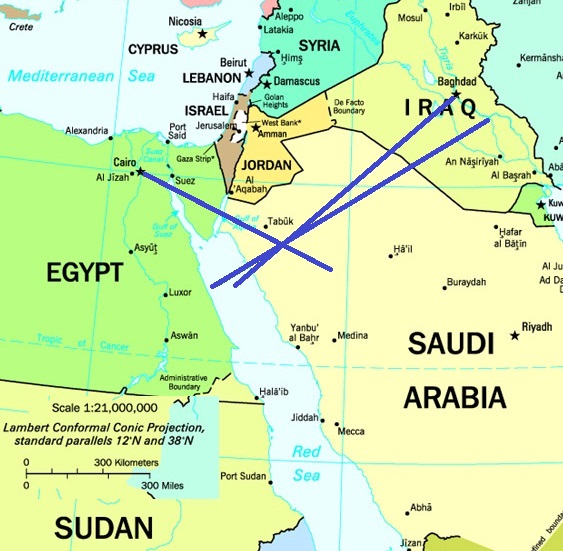
In other words the Qiblas indicate a position almost 500 miles to the north-northwest of Mecca. Here's a Wikipedia map that includes Al-Ula (just below Mada'in Saleh).
Here's a Wikipedia article on "Ancient Towns in Saudi Arabia" which does not include Mecca, because Mecca is not an ancient town. The article does mention a town of:
"Mada'in Saleh: also called Al-Hijr
Also called Al-Hijr, this is an ancient city located in northern Saudi Arabia....
Mada'in Saleh is considered to be one of the most important and oldest ancient cities in the country. Mada'in Saleh lies to the northwest of the city of al-Ula..." (Mada'in Saleh map)
"Mada'in Saleh was recognized by the UNESCO as a site of patrimony[5], the first world heritage site in Saudi Arabia. The story of these people called the people of Thamud (including petra) is mentioned several times in the Quran along with prophet Saleh."
"A religious area, known as Jabal Ithlib, is located to the north-east of the site.[4] It is believed to have been originally dedicated to the Nabatean deity Dushara." (Wikipedia) (map)
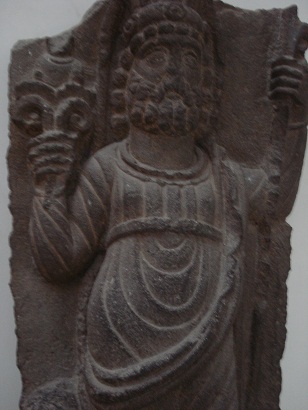
We learn that Dushara was mothered by Manat. Who did Mohammed recognize as Manat?
Sura 53.19 Have ye seen Lat. and 'Uzza, 20 And another, the third (goddess), Manat?
He recognized Manat as a daughter of al-Lat the sun goddess (and al-Lah the moon god) in what have been referred to as the "satanic verses" in the Quran. The deity Manat is found in pagan moon, sun and star worship as the daughter of the pagan's moon god.
It's interesting to see how Manat fits into Islamic rituals.
Today's Al-Ula was formerly Dedan which, according to George Potter from whom the photograph below was copied and who writes that Dedan is his "favorite exploring site in Arabia", are the remains of a Lihyanite temple which the Saudi Arabian Department of Antiquities has begun excavating. There are also stairs up to another temple site on a mountaintop. Mr. Potter writes, "Their Solomon like temples appear to have been used for sacrificing she-camels, black camels and other livestock to the God Dhu Ghaibat." Link to more
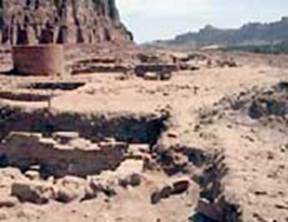
On one thing we can be confident of is that the Qiblas of the most ancient mosques do not point to Mecca, but rather more likely to pagan deities, to which even Muhammad's tribe the Quraish continued to go on pilgrimage to long after he invented his religion.
Quran 106:1 For the covenants by the Quraish, 2 Their covenants journeys by winter and summer,- 3 Let them adore the Lord of this House,
Many Kaabas throughout Arabia included stone idols and were dedicated to Arabian Star Family worship, which was the same reason that the Kaaba in Mecca was built, likely in the early 5th century by Asad Abu Karb. It housed some 360 idols according to the Islamic Hadith.
Muhammad's Genealogy
In order to make the claim that Mohammed was descended from Ishmael, 8th century Islamic history creator Ibn Ishak even invented a genealogy for him. This was of course done without a single historical reference that preceded Mohammed. Sadly, for Muslims - even today - Ishak's genealogy trumps the one we received through Moses and the record of the Old Testament. Not only did Ishaq assign what were, from his tribe the Quraysh, at the time modern Arabic language names to the characters he created in Mohammed's lineage, that were supposed to have lived thousands of years before, but he included only 40 generations between the two.
There are 2,670 years between Ishmael and Mohammed. Suggesting only 40 generations, would require over 66 years per generation. Yet we know from actual Arabian historical record that the average Arabian generation was about 17-20 years.
Mohammed himself had a 6 year old "wife", that he consummated his marriage with when she was 9 years old, so a generation of 17-20 years is not a surprise. Indeed Muslims try to legitimize that marriage by declaring that desert dwelling girls reached sexual maturity earlier than girls in other parts of the world, and that is what they suggest determines whether a girl is of child bearing age, though I don't believe the medical community would agree. Indeed Mohammed's violation of a 9 year old is perhaps what made Aisha barren.
So then the 2,670 years between Ishmael and Mohammed, divided by 20 year generations, would have required over 133 Arabic generations between them. So Ishak not only invented characters of a couple thousand years before, and ascribed 7th century style Quraish Arabic names to them, but also spanned 2,670 years with only 40 generations.
However, according to many hadith writers, Mohammed himself prohibited any tracing of his genealogy past the 17th generation. This is one reason that Ibn-Ishak was considered by the Muslim scholars of his time as being guilty of forgery and fabricating false genealogies. From "Islam: In Light of History".
"Long before Ibn Ishak, Muslims who lived in Mohammed's own time also fabricated genealogies in an attempt to connect Mohammed to the descendants of Ishmael. Mohammed, himself rejected all of those false genealogies, and he put limits regarding the genealogy of his ancestors. Amru bin al-As wrote:
'Mohammed genealogized himself regarding his ancestors until he reached al-Nather bin Kinaneh, then he said 'anyone who claimed otherwise or added further ancestors, has lied.'"
A couple thousand years of history isn't something that is recalled and recorded by a single man named Ibn Ishak, 2,500 years after the fact, but rather is the record that was noted by the people that lived in or near the times that were written about. Whether in cave paintings, on stone monuments, bowls, pottery, or a written record of the times. Yet Islamic "tradition" was created in the 7th and 8th centuries, without reference to historical record that predated the late 4th century AD.
Muslims even today hold that Mohammed was a descendant of Ishmael, not only in spite of Mohammed's own prohibition against it, but even in light the fact that the name Ishmael does not occur in a single instance within the archaeological or historical record of Arabia, prior to the pens of the 7th and 8th century Islamic "tradition" fabricators. Compare that with the use of the name Isaac, throughout the history of Israel, for example.
Interesting they would want to draw attention to Edward Gibbon as he correctly characterized of the Quran:
"Instead of a perpetual and perfect measure of the divine will, the fragments of the Koran were produced at the discretion of Mahomet; each revelation is suited to the emergencies of his policy or passion; and all contradiction is removed by the saving maxim that any text of Scripture is abrogated or modified by any subsequent passage." – Edward Gibbon.
Footnotes
1 - From book 5 of Agatharchides of Cnidus, on the Erythraean Sea, excerption from Photius, bibliotheca, cited by Burstein, page 148-fragment 87a